Healthline News RSS Feed – Read More

- The tax and spending bill approved by Congress last month will cut $1 trillion from health-related programs over the next decade.
- The “One Big Beautiful Bill” will hit Medicaid hardest with $790 million chopped from its budget.
- Experts say these reductions will greatly impact health programs across the country, particularly those serving rural communities, children, and lower-income households.
The so-called One Big Beautiful Bill Act (OBBBA), signed by President Donald Trump in early July, will impact virtually every health-related program in the United States.
The bill, officially known as House Resolution 1, is expected to reduce federal spending on health-related programs by $1 trillion between now and 2034.
It’s estimated that those cuts will cause at least 10 million people to lose health insurance coverage during the next nine years.
It calls for a reduction in funding for food assistance programs and rural hospitals, as well as reduced funding for Planned Parenthood services, which have been temporarily blocked by a federal judge.
Some of these impacts will take years to be felt. Other provisions, however, could directly affect people’s lives in the next year or two.
”It is the biggest cut to our social safety net in history,” Liz Fowler, PhD, a distinguished scholar in Health Policy and Management at the Bloomberg School of Public Health at Johns Hopkins University in Maryland, said in a news release from the college.
Here’s a look at six key areas affected by spending reductions outlined in President Trump’s “Big Beautiful Bill.”
Medicaid bears the brunt of the cuts
Federal funding for Medicaid is expected to be reduced by more than $790 billion over the next decade.
More than 70 million people currently receive Medicaid benefits, but various factors could significantly reduce this estimate.
- Work requirements will mandate that most “able-bodied” recipients between the ages of 19 and 64 will be required to work, receive work training, volunteer, or be in school for at least 80 hours per month while receiving benefits. The new work requirements take effect on January 1, 2027. As many as 5 million people could lose health insurance due to this requirement, according to the Kaiser Family Foundation (KFF).
- More frequent eligibility checks will require states to verify beneficiaries’ eligibility for Medicaid more often, causing some recipients to be removed from the program.
- Immigration restrictions will reduce the number of foreign-born residents receiving benefits.
The cuts may also affect hospitals, as Medicaid is responsible for 20% of revenue at these medical facilities nationwide.
Experts also point out that people who are no longer on Medicaid will not seek preventive care and end up in hospital emergency rooms due to more serious medical issues.
“Cutting Medicaid means millions lose access to basic care, leading to sicker patients, overwhelmed ERs, and rising costs for everyone,” said Kanwar Kelley, MD, a specialist in otolaryngology, head and neck surgery, obesity medicine, and lifestyle medicine as well as the co-founder and chief executive officer of Side Health.
“Lack of access to preventive care leads to a sicker population, which leads to more medical expenses,” Kelley told Healthline.
Impacts to Medicare
Medicare is a federal program founded in 1965 that provides health insurance coverage to people 65 years and older. About 66 million Americans are enrolled.
Trump’s bill does not directly mention Medicare cuts, but there are measures that could impact recipients.
Under a 2010 budget mechanism law known as PAYGO, the Congressional Budget Office estimates the Trump bill could trigger more than $500 billion in Medicare cuts between 2026 and 2034, KFF reports.
The Center for Medicare Advocacy notes the bill will also reduce the number of people eligible for Medicare. They say some non-citizens who meet Medicare eligibility requirements through work history or residency length will no longer be covered.
In addition, the bill imposes a nine-year ban on implementing improvements to Medicare Savings Programs that help lower-income Medicare beneficiaries pay for premiums and out-of-pocket costs.
Older adults who are enrolled in both Medicaid and Medicare could hit with a double impact.
“The [bill] will affect this [older] age range by reducing access to care,” Kelley said. “Creating restrictions based on work requirements and new regulations for exemptions will exclude many in this age group from qualifying. Those in this age range will have a harder time re-entering the workforce to continue their coverage.”
Fewer people enrolled in Obamacare
The bill will make it more difficult for people to join or remain in programs offered by the Affordable Care Act (ACA), also known as Obamacare.
This difficulty will be due to several changes. They include:
- Requiring enrollees to update their information regularly. This may include updating income, immigration status, and other details each year.
- Requiring individuals to manually reenroll every year during open enrollment. Last year, 10 million people were automatically reenrolled.
- Shortening the open enrollment period by a month. That period will now end on December 15 rather than January 15. For the current plan year, 40% of people signed up after December 15.
Some immigrants will also no longer be eligible for ACA coverage.
In addition, financial assistance that helps people afford insurance in ACA marketplaces will be allowed to expire at the end of this year.
The Bloomberg School of Public Health at Johns Hopkins University predicts these changes will cause ACA premiums to rise by 75% next year.
Kelley agrees that premiums will likely go up, causing a cascade of events.
“Removing or cutting these subsidies will lead to more expensive plans offered on the marketplace. By raising these prices, many will choose to live without health insurance and risk catastrophic medical debt,” he said. “Making access to healthcare harder for individuals creates gaps in care for patients, which is crucial in screening for life-altering illnesses.”
Strains on rural hospitals
The bill does provide rural hospitals with $50 billion over the next five years to help reduce the effects from the cuts in Medicaid spending.
However, the Center for American Progress reports that funding will not be nearly enough to make up the difference.
The organization states that slightly more than 2,000 rural hospitals receive $12 billion per year in net revenue from Medicaid.
At some rural hospitals, Medicaid represents 40–50% of their revenue.
The organization added that children, non-elderly adults, and people with disabilities would be the people in rural areas most affected.
Kelley agreed that the effects could be far-reaching.
“This loss of funding will hit rural hospitals hard, leading to closures and increasing healthcare disparities in marginalized neighborhoods,” he said.
The Center for American Progress also notes that rural hospitals have low operating margins. They project that more than 300 rural hospitals could be at risk of closure.
“Rural communities already face challenges with adequate staffing and medically necessary equipment as they usually operate on tight margins with the subsidies,” Kelley said. “Reducing the number of providers will lead to closures, which forces those in the community to travel farther for their regular and emergency care.”
Fewer families will receive food assistance
The bill would cut $120 billion from the Supplemental Nutrition Assistance Program (Supplemental Nutrition Assistance Program (SNAP) over the next decade, according to estimates.
About 40 million people currently receive assistance from the SNAP program. The League of Women Voters projects the cuts could impact 22 million families.
Kelley said the impact is beyond just food.
“Food insecurity leads to bad health outcomes,” he said. “Cutting programs directed at addressing hunger will lead to increased rates of obesity, diabetes, and poor nutrition in kids.”
“Hunger in children leads to poor educational outcomes. Cutting SNAP and other food programs will lead to children going to school hungry, seniors skipping meals, and families making decisions between food and other necessities, including health,” Kelley added.
Cuts to Planned Parenthood
The bill impacts Planned Parenthood operations by banning people from using Medicaid at healthcare non-profit facilities that provide abortion services outside of cases of rape, incest, or when the pregnant person’s life is in danger.
Planned Parenthood estimates that the new law could close nearly 200 of its facilities. About 60% of those centers are in medically underserved communities.
In addition, the organization states that more than 1 million people could lose access to afford healthcare services such as STI testing and birth control.
Miller Morris, MA, MPH, is a women’s health researcher and founder of Comma, a service focusing on menstrual health. She notes that a court injunction has temporarily blocked the bill’s ban on Medicaid use at reproductive health clinics like Planned Parenthood.
However, she said if the provisions are eventually upheld, they could have far-ranging effects.
“If the court’s injunction were to be lifted, the defunding of Planned Parenthood would mean fewer resources for all the preventative and primary care services they offer, leading to reduced access for millions of women, especially those in low-income and rural communities,” Morris told Healthline.
“This reduction in Medicaid funding will see catastrophic consequences for the millions of women who rely on Planned Parenthood and similar low-cost organizations for vital, life saving care,” she added.
“As Planned Parenthood is also a crucial provider of prenatal and pregnancy care, it’s clear that this isn’t about saving babies. It’s about exerting control over women,” Miller said.




